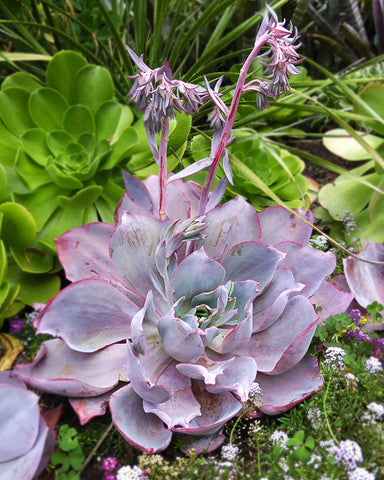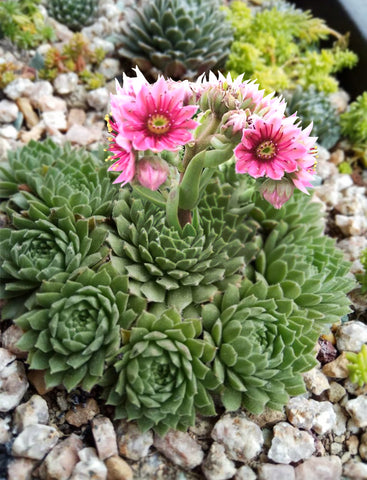Succulents have long captured the hearts of plant enthusiasts with their unique forms and low-maintenance nature. But did you know that these delightful plants can also surprise us with their stunning blooms? Blooming succulents add an extra layer of charm and intrigue to any indoor or outdoor space. In this article, we'll explore the top 10 popular blooming succulents that can bring bursts of color to your collection. We'll also delve into how to encourage their blooms and provide essential care tips for after they've graced us with their radiant blossoms.
1. Echeveria 'Afterglow'
With its captivating rosette of pastel-hued leaves, Echeveria 'Afterglow' is a favorite among succulent enthusiasts. To promote its blooms, ensure it receives ample sunlight – at least 6 hours of indirect sunlight daily. As the temperatures rise in spring and early summer, you'll witness its tall flower stalks adorned with coral-pink flowers. After blooming, snip off the spent flower stalks to divert energy back to the plant. Continue to water sparingly, allowing the soil to dry out between waterings.
2. Kalanchoe blossfeldiana
Kalanchoe blossfeldiana, commonly known as Flaming Katy, is cherished for its clusters of vibrant, long-lasting flowers. These blooms thrive in bright, indirect light. To encourage blooming, provide a period of darkness for about 6 weeks by placing a box over the plant in the evenings. After blooming, deadhead the spent flowers and trim any leggy growth. Keep the soil moderately moist, and you'll be rewarded with another round of blooms.

3. Sedum 'Autumn Joy'
Sedum 'Autumn Joy' is a hardy succulent that dazzles with its late-season blooms. These blooms attract butterflies and bees, making them a great addition to pollinator-friendly gardens. For optimal blooming, ensure your Sedum receives full sun to light shade. As the flowers fade, trim the stalks to promote a tidy appearance. Once the blooms have finished, this succulent's fleshy foliage will continue to add interest to your garden.
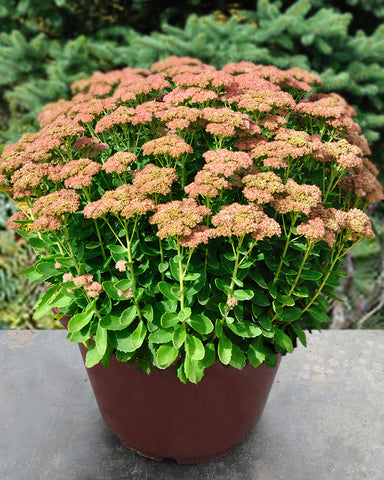
4. Aloe 'Cameronii'
Aloe plants are renowned for their soothing gel, but Aloe 'Cameronii' also stands out with its striking coral-red blooms. To promote flowering, place your Aloe in bright, indirect sunlight. As the plant prepares to bloom, you'll notice the emergence of tall flower spikes. After blooming, allow the flower stalks to remain until they wither completely, as they provide nutrients to the plant. Water your Aloe moderately and let the soil dry out between waterings.

5. Euphorbia milii (Crown of Thorns)
Euphorbia milii, known as the Crown of Thorns, boasts colorful bracts that surround its tiny flowers. To encourage its blooming, place it in bright light, preferably near a south-facing window. Keep the soil slightly dry, allowing the top inch to dry out before watering again. After its blooming cycle, prune back the stems if needed and resume regular care. Be cautious while handling this succulent, as its sap can cause skin irritation.

6. Graptopetalum paraguayense (Ghost Plant)
Ghost Plants are known for their ethereal appearance and delicate, star-shaped blooms. To promote blooming, provide bright but indirect sunlight, especially during the growing season. As the weather warms up, your Ghost Plant will send up flower stalks adorned with petite pink or yellow flowers. After blooming, allow the stalks to remain until they naturally wither. Water sparingly and avoid getting water on the leaves to prevent rot.

7. Aeonium arboreum 'Zwartkop' (Black Rose)
Aeonium 'Zwartkop' stands out with its dark, velvety rosettes that take on a rich, almost black hue. In spring, it produces cone-shaped clusters of yellow flowers atop tall stalks. To encourage its striking blooms, position it in full sun to light shade. After flowering, trim the spent stalks to maintain the plant's shape. Water deeply but infrequently, allowing the soil to dry out between waterings.
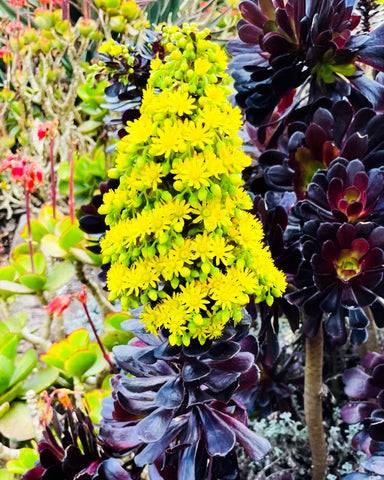
8. Gasteria 'Little Warty'
Gasteria 'Little Warty' charms with its textured leaves and occasional spikes of tubular flowers. For optimal blooming, provide bright, indirect light and protect it from harsh afternoon sun. As the plant prepares to bloom, you'll notice the emergence of a slender flower stalk. Once blooming is complete, allow the stalk to wither naturally. Water the Gasteria moderately and maintain well-draining soil.

9. Haworthia cooperi
Haworthia cooperi showcases its beauty through its translucent leaves and dainty white flowers. To encourage blooming, place it in bright, indirect sunlight or partial shade. As the plant enters its flowering phase, you'll witness the emergence of delicate flower stalks. After blooming, let the stalks remain until they wither. Water sparingly, allowing the soil to dry out between waterings.
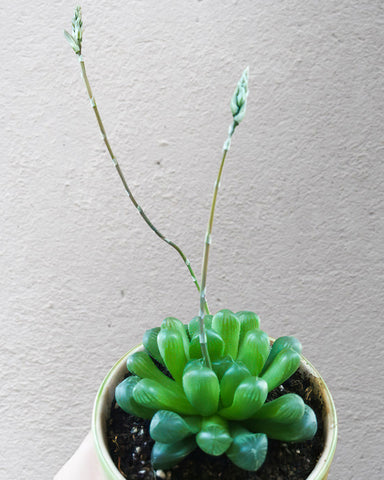
10. Sempervivum tectorum (Hens and Chicks)
Known for their resilience, Hens and Chicks produce charming rosettes and occasionally send up tall, slender flower stalks. To promote blooming, provide bright light and well-draining soil. As the plant gears up for blooming, you'll notice the appearance of delicate, star-like flowers in various colors. After blooming, remove the spent flower stalks to encourage the growth of offsets around the mother plant. Water sparingly, allowing the soil to dry thoroughly.
Final Thoughts
Blooming succulents offer a delightful surprise, showcasing nature's artistry in the most unexpected ways. By providing the right conditions and care, you can witness these succulents transform from understated greenery to vibrant bursts of color. Remember, each variety has its own preferences and tendencies, so observing your plants closely will help you tailor your care routine to their specific needs. Embrace the beauty of blooming succulents and enjoy the ever-changing tapestry they bring to your succulent collection.


